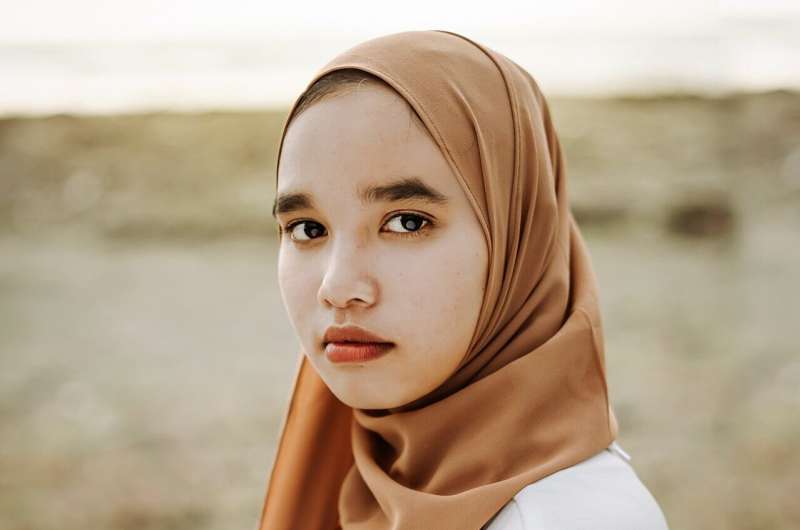This article has been reviewed according to Science X's editorial process and policies. Editors have highlighted the following attributes while ensuring the content's credibility:
fact-checked
trusted source
written by researcher(s)
proofread
Researchers: Girls in hijab experience overlapping forms of racial and gendered violence

World Hijab Day recognizes the millions of Muslim women and girls who wear the traditional Islamic headscarf.
Around the world, Muslim girls in hijab are experiencing unique forms and heightened rates of gender and race-based violence and discrimination. Overt violence against girls and women in hijab have captured global attention, evidenced most recently in the violent Canadian attacks on women in hijabs in Alberta and the horrific murders of the Afzaal family in London, Ont.
Violence against hijabi girls is often situated in structural oppression, including gendered Islamophobia and white supremacy. Understanding the underpinnings of this violence is key to imagining more just and equitable futures for girls and young women in hijab.
Islamophobia
The term Islamophobia has often been used and understood in different ways. While often used interchangeably, some have argued that the term anti-Muslim racism, rather than the term Islamophobia, better encapsulates the systemic nature of anti-Muslim hate and violence.
Sociologist and Muslim studies scholar Jasmin Zine has outlined how Islamophobia in Canada is comprised of systemic oppressive networks and industries that are both fueled by and fuel anti-Muslim racism. Zine explains that an "industry behind purveying anti-Muslim hate" distinguishes Islamophobia from other forms of oppression.
According to Zine, this well-funded, lucrative and often transnational industry is comprised of media outlets, political figures and donors, white nationalist groups, think tanks, influencers and ideologues that support and engage in "activities that demonize and marginalize Islam and Muslims in Canada."
Gendered Islamophobia
Islamophobia and anti-Muslim racism is part of the fabric of institutions. Critics of laws such as Bill 21 in Québec and similar measures in France have argued that Muslim women who wear the hijab are most affected. These measures reflect narratives that position Muslim girls and women as oppressed victims in need of rescue, as well as Orientalist tropes in the form of the "save us from the Muslim girl" narratives.
As Muslim women in hijab, we grieve horrific violence alongside our communities. Violent attacks highlight how anti-Muslim racism is often situated at a nexus of anti-Black racism, xenophobia, white supremacy and patriarchy.
We know that anti-Muslim violence is often aimed at girls and women in hijab. Yet, academic literature on hijabi girlhood is relatively scarce. Two years ago, we put out a call to the international academic community seeking papers and creative submissions on the experiences of girls and young women in hijabs.
The girl in the hijab
Two years later, our new special issue, called "The Girl in the Hijab," has now been published in the journal Girlhood Studies. It comes at a time when anti-Muslim, anti-Arab and anti-Palestinian racism are on the rise around the country and around the world.
The special issue includes academic articles written by mostly Muslim women and creative works produced by hijab-wearing girls themselves. Both types of work provide insight into the current global landscape of hijabi girl experiences.
Cultural politics lecturer Noha Beydoun explores the events surrounding the donning of the American flag as a method of protest. She finds that this phenomenon gained popularity because it worked to conceal complicated U.S. histories regarding Muslim immigration and broader imperial interests. Beydoun's analysis evidences that the "American flag as hijab for girls and women reinforces the larger constructs it seeks to resist."
Gender studies professor Ana Carolina Antunes highlights how unconscious bias and microaggressions hinder a positive sense of belonging among hijab-wearing students and impacts their academic success. This study also reveals that anti-Muslim sentiment in schools affects the everyday experiences of Muslim girls, leading to disconnection from the school community.
Among the central themes in the special issue is how women and girls resist gendered and Islamophobic discrimination in their everyday lives. Hijabi girls resist oppressive narratives through their everyday actions and activist engagements. In Antunes's study, girls asserted their right to occupy space in the educational environment.
Clinical social workers Amilah Baksh and her mother, Bibi Baksh, provide insight into their lived experiences as Indo-Caribbean social workers and university educators. In their article, they identify the hijab as a form of resistance and resilience in their personal and professional lives. In their words, "it was never the hijab that rendered us voiceless. It is Islamophobia."
The special issue highlights how Muslim girls and women, racialized through donning hijab, continue to be at the forefront of the struggle against Islamophobia and anti-Muslim violence, even as we remain among the primary targets of that violence.
The articles in this special issue demonstrate the need for better policies, education and laws that consider the unique experiences of girls and women in hijab. To counter violence against girls and women in hijab, we must name and understand the complexities of anti-Muslim racism and gendered Islamophobia.
Critically, this must center the voices of girls and women in hijab, opening or widening spaces for girls and women in hijab to practice acts of resistance in ways that are not bound by colonial logics and respectability politics.
Provided by The Conversation
This article is republished from The Conversation under a Creative Commons license. Read the original article.![]()




















